Month: June 2015
Markets in everything does this violate a zero profit condition?
Henceforth you will be tipped a rupee to pee at the right spot! The Ahmedabad Municipal Corporation (AMC) is toying with a new idea of paying people money if they visit the nearest public toilets.
This idea was first implemented in Darechowk in Katmandu in Nepal and had worked well.
In Ahmedabad, the AMC will implement the scheme in 67 nuisance spots in the city with a public toilet nearby. Once successful, the scheme will be implemented across all public toilets in the city.
The full article is here, and for the pointer I thank Mark Thorson.
Did 19th century China have betting markets on individual performance?
I ran across this intriguing passage:
The Chinese also rejected the telegraph at first, partly because of similar feng shui concerns, but mostly because they didn’t believe such an invention had any real benefits. But once they learned that some wily Cantonese (a persistent regional Chinese stereotype) had enriched themselves by hearing the results of the triennial imperial exam in Beijing via telegraph weeks before everyone else, and then buying all the lottery tickets with the names of the top graduates, opposition to the telegraph crumbled.
No further information on those markets is offered, do any of you know more about this? The passage is from Huan Hsu’s new and noteworthy The Porcelain Thief: Searching the Middle Kingdom for Buried China. It’s not so much a book about porcelain, rather it is an excellent look at China and also the idea of a quest to discover one’s family history, recommended.
Monday assorted links
1. The Essential Hayek, by Don Boudreaux.
3. www.clickhole.com is a funny site and probably the best critique of the web I have seen. Here is Slate on the site.
4. Larry Summers on TPP makes perfect sense. I haven’t seen anything on the anti- side coming close to this level of analysis, and in a short column at that.
5. There is a skills gap and the Beveridge curve has shifted.
6. How and why Facebook automates.
7. Scott Sumner has two excellent posts on state taxes, here and here.
How will the sharing economy alter job training?
Samir Varma points my attention to this WSJ Christopher Mims piece:
Right now a college student in Sweden—let’s call him Sven—has a rather unusual summer job. He’s in sales, but he hasn’t met anyone from the company whose products he pushes.
His boss is an app. It considers Sven’s strengths and weaknesses as a salesman, matches him with goods from any of a dozen brands, and plots a route through Stockholm optimized to include as many potential customers as possible in the time allotted to him.
The app is like Uber, but for a sales force. It has many of the same dynamics: Companies can use it to get salespeople on demand, and those salespeople choose when to work and which assignments to accept.
I am very much an Uber fan, but if you are looking for drawbacks that passage expresses one potential problem. Pre-Uber, acquiring worker talent required lumpier investments on the part of the employer. You would hire a bunch of people, with the expectation of keeping them around for a while, and then train them to do a bunch of things. Some of them would work their way up the proverbial ladder, based on what you had taught them, many would not. But you would train and teach them quite a bit, if only because there was no alternative for getting things done.
In a “sharing economy,” a pre-trained worker is very often on call for a short stint, when needed. The employer thus has less need to invest in option value from the full-time work force and that means less training. The result is that more workers will have to teach and train themselves, whether for their current jobs or for a future job they might have later on.
I submit many people cannot train themselves very well, even when the pecuniary returns from such training are fairly strongly positive. The “at work social infrastructure” for that training is no longer there, and so many sharing economy workers will stay put at their ex ante levels of knowledge.
Uber thus shares the same property which is common to so many other parts of the new knowledge economy, namely that the return to self-training is high, and the return to not-self-training is low. This further helps those with high levels of discipline and conscientiousness.
Here is a good NYT article about French reluctance to accept Uber.
Bitcoin as a medium of settlement
This is relevant when thinking about bringing the next few billion people online and into the global economy. These people will not have credit histories that are accessible to the same intermediaries that I am set up to use. They may have local intermediaries that they can use, or they may be willing to use Bitcoin directly. If that is the case, they will be able to enter into the stream of global commerce.
There are not right now many transactions between rich countries and the bottom couple billion people on Earth. Why is that? Is it because these people have nothing of value to sell or is it because we have no way of transacting with them? We are about to find out.
Sunday assorted links
1. Virtual reality is being used to train quarterbacks.
2. Can we learn anything from the China of 1640? (speculative)
3. Models of models: “The most ideal model-producing places, she surmises, have lots of interracial marriage, a high G.D.P. (predictive of good teeth) and protein-rich diets (good for turning out tall but trim citizens).”
In praise of Porto
Porto is Portugal’s second largest city, but when you turn the corner you never know what is coming: a Baroque or even Romanesque church, wondrous blue tiles, a rotted out building, a coffee and pastry shop, port warehouses and embankments, or a steeply plunging street. If a store displays the sign “Novidades,” that is an indication they don’t have any. Porto is (not) the only European city with six bridges. My conference was held in a very fine Rem Koolhaas venue.
Magellan lived and studied here, and J.K. Rowling’s Porto stint shaped parts of Harry Potter. Libreria Lello is perhaps the most striking bookshop in Europe.
This politically incorrect shop sign would have been taken down a while ago elsewhere in Europe; it is a reflection of the city’s remnant status. The modern parts of town, along the ocean, remind me of California. But the English language section of a used book store will have the titles which were British bestsellers in the 1920s. A 1970s tribute store is called “Spock,” and its sign outlines the Starship Enterprise.
Eat the tripe and white beans at Flor de Congregados, or for fancy try DOP restaurant, worthy of a Michelin star or two but not priced to boot. Peer into the apartments which open out onto the streets of the old town, due to the lack of air conditioning, and check out their crumbling wallpaper and tightly packed collections of icons. Here are ten things to like about Porto.
If you took the brain of Maria Popova, and turned it into a Mediterraneo-Atlantic city, loaded with debt, you would have Porto. Definitely recommended.
The political economy of Kansas fiscal policy (from the comments)
MR commentator Patrick L. has a go at it:
OK I’ll bite.
In nominal terms, between 2002 and 2012 state receipts grew 50%. Inflation in this period was 28%, and probably significantly lower for Kansas, while population growth has only been about 10% since 2000. Even the “low” 2014 receipts are $1.5 billion more in revenue from when Sebelius first took office and the government started rapidly growing. In the past 15 years expenditures have grown over 50%, exceeding $6 billion today. The shortfall is $300 million, or about 5%. While the growth of the Kansas government in the past 15 years is smaller than other governments in the country, it still explains the shortfall. We can justify this increase by saying that education and health are rising faster than everything else, but that is not a revenue problem. Tax rates have to rise because education and health costs are growing faster than our economies. That says nothing at all about the optimum size of taxation for state governments with regard to growth, jobs, or even revenue. The tax and spending levels Brownback choose would have been adequate ten, maybe even five years ago. With a bit of luck, he could have ignored the shortfall because of variance, which for receipts can be a few hundred million a year.
Republicans should be wise enough to not depend on luck, and they should be wiser predicting how trend lines go. Cutting the size of government was never a serious option.
I haven’t looked at the votes in depth, but it looks like a classic case of urban // rural split that typically troubles the state’s politics. Just under half the state’s population lives around Kansas City or Wichita, which are both five times than the next largest city. These places have as many votes as the rest of Kansas combined, but their needs are radically different.
Rural Kansas has two unique problems. First, there’s the problem of population collapse, which all farm states are seeing. What few children are born move out when they come of age and new people are not moving in. Fixed costs like “We need at least one school building” or “We need at least one teacher per grade” start to add up for small towns of 1000 or less. Those are the obvious problems, not to mention any number of federal or state concerns dealing with food, medical, or disability services that have to be met. As a matter of geography, 98% of the state is rural, and I think I heard 25% of the state is in towns less than 2500 – with over 400 municipal governments servicing less than 1000 people it’s probably the highest per capita in the country (This is FIVE times the national average).
This is a non-trivial growing problem related to scale government services that has been an issue of intense legal debate in the state. Wichita School District’s scale is such it can use its buses to deliver free or low cost lunches to children in the summer. Small cities don’t have buses. Is that fair? How should taxes be structured to compensate? The only political viable solution to this problem has been to spend more money. If all the small towns could magically consolidate into a super smallville, taxes would (back of the envelope) be 10-15% lower.
Government services to low population areas are subsidized by high population areas, and it costs much more to deliver the same services to small towns. The US Postal Service paid for delivery to small towns across the country by charging monopolistic prices on first class letter mail in cities (Which cost almost nothing to deliver). NPR’s national budget mostly goes to setup stations in small towns. The small towns in Kansas are both relatively and in many cases actually getting smaller, older, and poorer. They are costing more and delivering less.
The other problem is that some rural areas are *growing*, but they’re growing because of immigration attracted to the agriculture and food packaging industries. Which is not the same as growing from a resource boom which can be taxed heavily to compensate. Liberal, KS is the largest per capita immigrant community in the United States. While this influx of people is necessary for the health of these places, the new population has more expensive demands on government services and pays less in taxes. Some of these small towns are the same ones that a decade ago were collapsing. Services and infrastructure might have been allowed to lapse or removed, and now rapidly needs to be replaced. That’s expensive! In the long run this problem might replace the first problem, but for now it’s the worst of both worlds.
The economy of the small cities is based largely around food production, which mostly can’t move, and food packaging, which probably can’t for logistical reasons. These places are poorer, getting relatively poorer per capita, and demanding more in services both directly (immigration / aging) and through scale issues. Their populations are either getting very old or very Hispanic, or both.
In contrast, Kansas City is a stable metropolis whose economy depends on manufacturing is built around a national centralized hub for trains. It also has some finance and telecom sprinkled in, though those guys can probably go anywhere. Wichita, is a moderately growing city based around aircraft manufacturing. When state taxes can’t provide enough government services, local taxes for these areas easily rise to compensate. Their economic concerns are how to stop businesses from going across the border to Omaha, Oklahoma City, Tulsa, Springfield, or Kansas City, Mo – places which are functionally identical and just as close. Given their dependence on manufacturing, they also have to consider movement across international borders to China and Mexico. Their demography is much closer to the national averages rather than the extremes. They are large enough that they can take advantage of scaling for government services, without being so large that there is decreasing actual returns. I don’t have figures, but I’d guess income rates in the urban areas to be between 150 and 200% those of the rural areas, which are themselves typically around 2/3rds the national average. This is an industry effect, a farmer in Kansas City and an aeronautical engineer in Greensburg, KS would not make much money. The cities are richer, but they’re richer because they have industries that are becoming increasingly easier to move.
On a political level, normally cities become more liberal, and poorer as you go deeper into the city – a leftover of 19th century industrialization competing against 20th century transportation. Deep urban cores produce these deep blue constituencies that act as checks on conservative suburban rings. In some states this manifests itself as a coalition between the poor rural areas and the poor urban areas against richer suburban areas allowing normal American class politics to balance itself. Cities produce political equilibrium: The richer and denser it becomes, the more liberal, which pushes more money and voters to suburbia, diluting the power. In short, declining rural power (D) and rising urban power (D) offset each other, but rising urban power (D) enhances suburban power (R), and so at a state level you get a balance.
The problem is that the inner core of Kansas City is in Missouri, so Kansas only gets the rich (Republican) suburban ring and a tiny blue part. Typical democratic concerns like maintaining a progressive tax structure can’t really find a foundation. While Wichita also has an urban core that does provide a Democratic representation, the city isn’t constrained geographically by anything (No ocean, mountain, lake, and transportation goes around, not through, the city) means concentration, an ingredient for populist politics, is lessened. The city spreads, and the poor can easily move up the class structure by moving further and further out. Wichita has half the population density of Syracuse and two thirds that of Madison, two close sized metropolitan areas. I haven’t done a county level comparison, but I suspect that Sedgwick has half the density of the ‘average American county with half a million people’ in it. There are other places in America like that, but guess how they vote.
Nor are either cities big university cities, like Madison or Boston. The two big universities in the state are in the small towns of Lawrence and Manhattan, which are quite separate from the rest of the state. Urban centers are places of “Commanding Heights” industries, like health and education that can’t easily move, but Wichita and Kansas City are based around manufacturing.
The political outcomes are not that surprising at all. There is nothing ‘the matter with Kansas’. The power structure easily shifts between slim majorities formed from predominately suburban populations who are wealthier, and whose jobs are most likely to move, and slim majorities formed from the small urban cores and rural parts of the state.
There’s no possible political coalition that you could form that would pass a constitutional amendment allowing a floating balanced budget over a 10 year period. Nor are the populist pressure strong enough to push against regressive taxation. You have ‘fiscal hawks’ in the rural areas who never vote for cuts, and suburban conservatives who never vote for taxes. When the storm gets too bad, they vote a nice moderate democrat in to raise taxes and crack down hard on whatever (Non manufacturing / agricultural) big business they can put pressure on. Obviously something that can’t move easily like Health Insurance.
In summery, this really is an issue of Urban vs Rural politics. Unlike other cities, the kind of industries around Kansas City and Wichita can move. The jobs in the rural areas can’t. The rural areas require more per capita government services, and the urban areas have more money. They both have half the vote. Solve for equilibrium.
== As for the deal:
It’s mostly a .4% sales tax increase, which is less than some of the more fanciful projects done by local governments in the past 15 years, which have included sports arenas, loans to movie theaters, and waterfront improvement. A half cent increase in sales tax does move the state into the top 10 for the country, but the overall tax burden is still quite low. The real problem is that city/county sales taxes are a function of distance from Wichita, and the inverse of population. The smaller your city, and the farther you are from Wichita, the more the county depends on sales taxes. In places like Junction City, this could put the sales tax close to 10%! The real disparity is going to be at the border towns: After the change there will be a .7% difference between KC, KS and KC, MO, though I bet the Missouri side will raise taxes to compensate. After the increase, there’s a 1.5% difference between Pittsburg, KS and Joplin, MO – big enough that I could see some people consider driving for purchases more than $300 (Biweekly grocery shopping for a large family?), especially if retailers on the Missouri side are not dumb. As a general rule, the money and the shopping is on the Kansas side of the border, so stuff isn’t going to transition immediately, but I expect some Laffer curve effects here for local governments, and I would hope they’ll respond by dropping taxes to compensate.
This is probably WHY such a deal was able to pass. Most of the damage goes on the poor and rural parts of Kansas, which is where most of the balance budget hawks are. The rich living near Kansas City will have the easiest time dodging the increase and avoid it more often. A regressive tax, but an efficient one.
As for the other parts of the deal, $90 million in itemized deductions are being removed. I don’t actually think this will amount to much, since there aren’t many itemized state deductions left. What remains are things like adoption, historical preservation, or disabled access. I don’t see much money coming in this way, and the state will almost certainly reverse itself the first chance it gets (As it did the last time it got rid of the adoption credit).
Whew!
Did Iceland reject fiscal austerity?
Scott Sumner serves up the appropriate links. He cites Mark Sadowski, who tells us:
…Iceland’s general government budget ran a surplus equal to 1.8% of GDP in 2014, or a change in fiscal stance since 2009 equal to 11.5% of GDP. This can be found on Table A1 of the April 2015 IMF fiscal Monitor.
…Table A3 shows that Iceland’s general government cyclically adjusted balance rose from a deficit of 10.0% of potential GDP in 2009 to a surplus of 2.7% of potential GDP in 2014, or a change of 12.7% of potential GDP…
But even this tends to understate the amount of fiscal austerity that Iceland has engaged in. This is because it includes the increase in spending attributable to rising interest payments on the national debt. To get a proper idea of the amount of fiscal austerity that Iceland has engaged in (i.e. cuts in direct spending and increases in taxes) one has to look at the general government cyclically adjusted primary balance which can be found in Table A4. Iceland’s general government cyclically adjusted primary balance rose from a deficit of 6.9% of potential GDP in 2009 to a surplus of 6.2% of potential GDP in 2014, or a change of 13.1% of potential GDP.
…By this standard Iceland has done about 30% more austerity than Ireland, over double that of the UK, roughly two and a half times as much as the US, and approximately five and a half times as much as Latvia. The only country that has done more fiscal austerity is Greece.
None of this should come as a surprise. When nearly all the other OECD members were busy implementing fiscal stimuli in early 2009, Iceland (joined only by Ireland) was engaged in a massive fiscal consolidation.
Scream it from the rooftops: massive fiscal austerity in Iceland. (Or should that be something like “gegnheill ríkisfjármálum austerity á Íslandi!”) There is plenty more detail and argumentation in Mark’s post. Here is my previous post on Iceland.
Hybrid reviewing systems
Gabriel Power emails me:
I have not seen anyone discuss this possibility of a hybrid open/classic referee process: Editors approve set of X reviewers (say 300). Then, every submitted paper can be reviewed by any approved reviewer. Editor then considers all reviews. If no review, then editor assigns or desk rejects. Issues: Incentives? Selection bias? Matching author quality with reviewer quality? Conflicts of interest? Pros and cons? I think it is intriguing. Sincerely yours — Gabriel Power
I would stress the goal is not to find the “best” reviewing system. Rather we are looking to set different reviewing systems in competition with each other.
Saturday assorted links
1. Is creativity research elitist?
2. Virginia Postrel on textiles and technology.
3. Is there a gender pay gap in tech?
4. Good Dani Rodrik powerpoints on labor migration (pdf).
5. A political economy take on Iceland’s financial crisis, involving Mancur Olson; this is a Master’s thesis from UBC.
6. Primer on Greek capital controls.
7. The winners and losers from the empirical shift in economics.
Has fiscal conservatism met an impasse at the state level?
The latest from Louisiana is that taxes are going up, but in a strange way that won’t be called a tax increase:
One of the most critical parts of the budget plan, and the part that attracted most of the debate, would raise no revenue and lighten no one’s tax burdens. But because of a complicated arrangement of tax credits, this plan could, by some interpretations, allow Mr. Jindal, a Republican, to say that despite millions coming in from cigarette tax hikes and tax break rollbacks, the state had technically not raised net new tax revenue.
Read the whole article, it is even weirder than that sounds. Combine that with the recent fiasco in Kansas, where the strongly Republican state government will be reversing earlier tax cuts.
It seems to me that, whether we like it or not, fiscal conservatism has been stymied at the state level. No, that’s not true for Illinois, New York, or California, but it does seem to be true for many other states, especially those governed by Republicans. (And yes, state pension obligations still do need to be reigned in and made subject to proper accounting.) More concretely, trying to cut taxes at the state level doesn’t seem like a useful or productive way forward.
If you have a better revisionist take on Louisiana and Kansas, please do put it in the comments, I would gladly read it, and if you have something really good I will pass it along. But I see myself as stating what has to be the default hypothesis for the time being — should we not all come out and admit this?
Puzzles of capital and equity returns
And as Matt [Rognlie] also stressed, the secondary big news in his numbers is the pre-1990 fall in the net capital share, a fall driven by a very real rise in depreciation is real. Our capital stock has seen the replacement of long-lasting machines to perform Wellman-Lord desulfurization reactions with video editing machines rapidly obsoleted by Moore’s Law.
But it is puzzling that the pre-1990 fall in the net capital share not matched by a decline in the relative capitalization of the corporate sector. Matt points out a steady rise in capitalization up to the late 1960s, followed in the 1970s by a “negative bubble”–truly absurdly high earnings yields on equities–that lasts well into the 1980s. Then we see a bubbly rise in the relative capitalization of the corporate sector since the start of the 1990s–a rise that persists in spite of sub-par business-cycle performance. Very puzzling.
The post is of interest more generally,
Friday assorted links
1. Bryan Caplan on the minimum wage, an oldie but goodie.
2. A good analysis of the potential pitfalls in Nevada school choice.
3. Do (some) chimpanzees get drunk?
4. Do psychoactive plants improve the hunting abilities of dogs?
5. Portuguese drug decriminalization wasn’t actually a huge de facto change (pdf).
In Baltimore Arrests are Down and Crime is Way Up
A debate forum at the New York Times begins:
A rise in gun violence in New York, Baltimore and other cities after months of angry protests over police killings of unarmed black men, have led some to see a ”Ferguson effect,” in which police, spooked by criticism of aggressive tactics, have pulled back, making fewer arrests and fewer searches for weapons.
But has a wave of murders and shootings brought an end to the long drop in crime?
I don’t think that we will see a sustained increase in crime at the national level. But there is no question that we are seeing a Ferguson effect in Baltimore–more precisely a Freddie Gray effect. Arrests in Baltimore have fallen by nearly 40% since Freddie Gray’s funeral and the start of the riots on April 27. In the approximately 3 months before the Gray funeral police made an average of 87.7 arrests per day, since that time they have made only 54.6 arrests a day on average (up to May 30, most recent data).
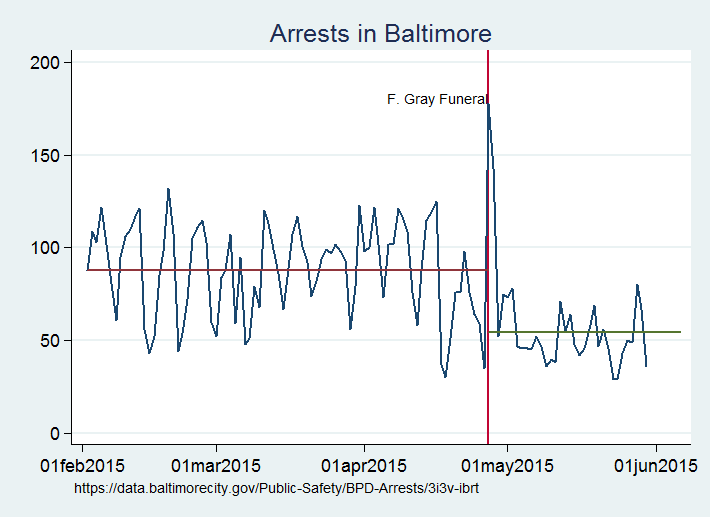
As Peter Moskos argues:
In Baltimore today, several police officers need to respond to situations where formerly one could do the job. This stretches resources and prevents proactive policing.
Not all arrests are good arrests, of course, but the strain is cutting policing across the board and the criminals are responding to incentives. Fewer police mean more crime. As arrests have fallen, homicides, shootings, robberies and auto thefts have all spiked upwards. Homicides, for example, have more than doubled from .53 a day on average before the unrest to 1.35 a day after (up to June 6, most recent data)–this is an unprecedented increase–and the highest homicide rate Baltimore has ever seen.
Put differently, the unrest in Baltimore and subsequent reduction in policing is responsible for roughly twenty “excess” deaths. (so far)
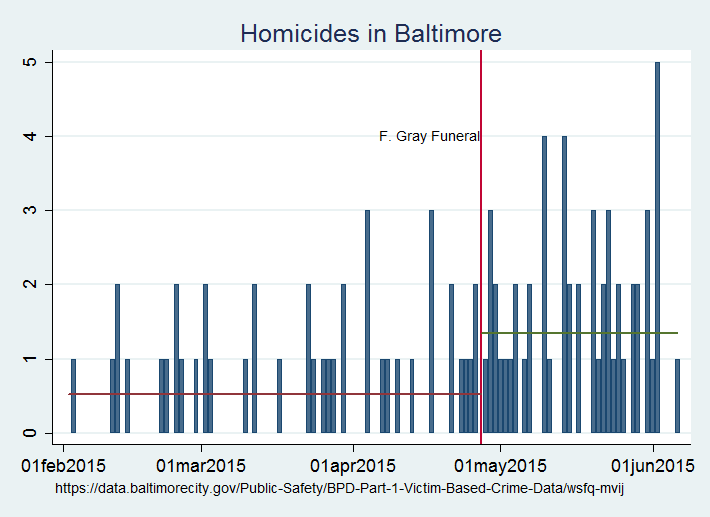
It’s not just homicides, the number of shootings in Baltimore has more than tripled. Shootings increased from .82 a day before the unrest to just over 3 a day. Since the onset of the riots there has hardly been a day without a shooting.
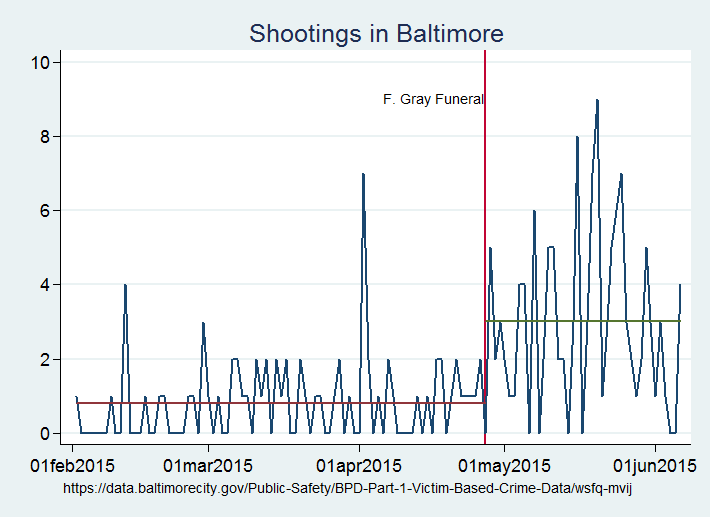
Robberies are up from 8.1 per day to 13.25 per day on average.
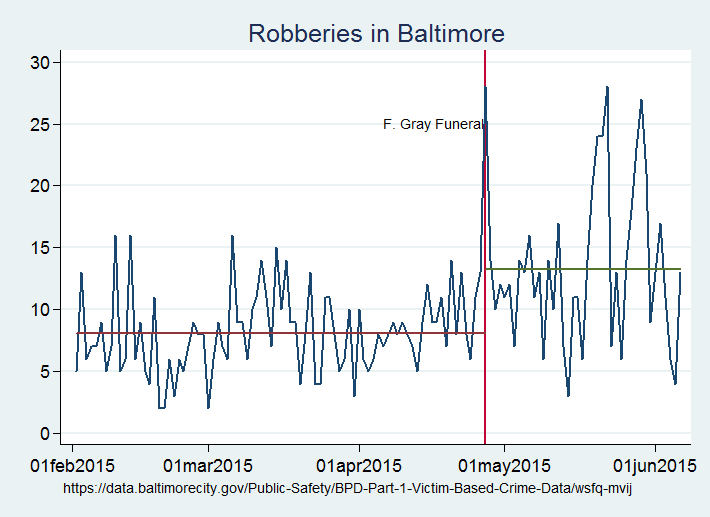
Even auto thefts are up from 9.6 per day to 13.6 per day on average.
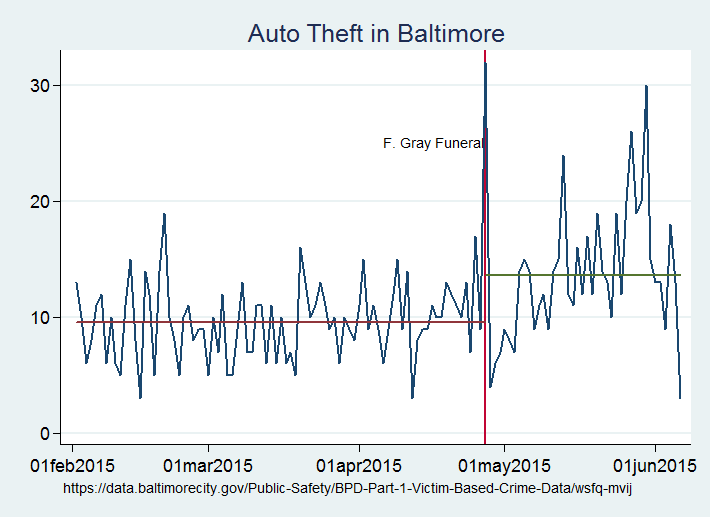
The increase in homicides and other crime is terrible and it is also putting a strain on police resources.
Police Commissioner Anthony W. Batts said the rise in killings is “backlogging” investigators, just as the community has become less engaged with police, providing fewer tips.
With luck the crime wave will subside quickly but the longer-term fear is that the increase in crime could push arrest and clearance rates down so far that the increase in crime becomes self-fulfilling. The higher crime rate itself generates the lower punishment that supports the higher crime rate (see my theory paper). In the presence of multiple equilibria it’s possible that a temporary shift could push Baltimore into a permanently higher high-crime equilibrium. Once the high-crime equilibrium is entered it may be very difficult to exit without a lot of resources that Baltimore doesn’t have. I have long argued that high-crime areas need more police but the tragedy is that they also need high-quality policing and that too is made more difficult to achieve by strained budgets and strained police.